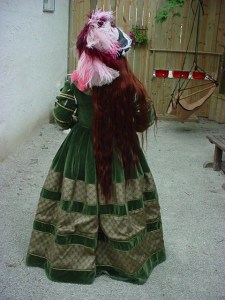This is a strongly germanic dress that would date to about
1535 or so. German costume history isn’t my strongest suit (I’m working on it),
so I’m not sure about the date. I’m absolutely positive that the construction
is not authentic (even beyond the fact that this dress might be accurately called,
“An Ode to My Serger” or, “Fabric Glues I have known”). The dress consists of
an underskirt of orange to green changeable silk, and an overdress of green
velvet, banded with brocade and trimmed with gold. The over dress is a skirt
and bodice that are sewn together at the back (from side seam to side seam)
and are separate at the front. That way, the skirt can be fastened and move
independently of the bodice in front, but will not separate from it in front.
The skirt is made in bands that are serged together. The gold trim was put on
while I was sewing the serged edges to the back of the velvet bands for added
stability. The skirt is only lined to about half way up. It is deliberately
made about 4″ too long, and has to be carried. (I can walk in a skirt that length
in a pinch, but it’s a little iffy on uneven ground. The underskirt is actually
about an inch long, because it does not have its hem treatment nor it’s proper
waistband on, and I do more or less fine on that, even while doing the incredibly
quick medieval shuffle run.)
The green part of the bodice covers the back and the sides
of the front. It’s lined with two layers of cotton duck, and boned. There are
two pieces of boning on each side that go from the side back, over the shoulder,
and down to the side front. This keeps the shoulders from ever drooping. It
worked out well, and I’ll do it again in the future. The front white thingy
(which I think is a plastron, although that might technically just be the band
– I’m a little fuzzy on that) is made of patterned cotton that matches the chemise
I’m wearing. The band is goldenrod silk woven with a pattern in gold threads.
The band is made as a tube, and is lined with thin batting so that it doesn’t
look flat and doesn’t rumple up. The band and the white cotton are both mounted
on a shield shaped support made of two layers of cotton duck with plastic canvas
for stiffening. The plastron laces into the green part of the bodice with internal
lacing strips. The lacing that you see over the front of the white is not really
stress bearing – all of the stress is taken by the internal lacing. The lacing
that you can see is there because a) it’s in all the paintings I looked at,
and b) it keeps the sides of the green bodice from flapping out funny. The first
day I wore it, I found out I had made the bodice too loose, and I kept, erm,
slipping. I took in the lacing panels inside the bodice and it fit better the
second day (except for a terrifying incident with the stitches holding the tuck
I took ripping when I was being laced in. Gods bless the safety pin manufacturers,
and keep them from harm.)
The sleeves are made from a single layer of velvet, and not
lined in any way. This was meant to be a hot weather costume, so I really cut
back on linings (then turned around and made the thing out of velvet. So terribly
clever, I is….) I marked where I wanted the slashes on both sleeves, then
sized the back of the velvet that was to be cut with fabric glue. (The stuff
you get at jo-anne’s that comes in a clear bottle, not the aleene’s stuff.)
After the glue dried, I used my sharp stork scissors to start the cuts, cut
them with a normal fiskers, and voila, slashed sleeves. Then I added the trim
to the right sides (more fabric glue, there), and sewed the sleeves up. The
sleeves were then sewn into the armscyes. I sewed too far around the armscye,
and popped the stitches on the right sleeve about thirty thousand times. I hate
popping stitches I can’t reach…
So, really, that’s about it. I started the pattern on a wed,
and wore the dress the following saturday. There are some things left I want
to do, and I want to make a new hat, but that wasn’t too bad…. It was made
entirely from fabric that I had, mostly so that I can justify keeping a fabric
stash as large as I have. ;)
Update: I added a new picture from this year. I lost a bit of
weight over the winter. To make this dress fit again, I removed the front panel,
and made the top gold band into a pinned in bust support. The front lacing now
actually *is* holding the dress shut, and the whit behind it is my chemise.
I think this is closer to the actual construction used in german gowns of the
1530s.




















I am studying your costumes and would like to have access to some of your pictures.
Thanks,
Noemi
[…] the Sempstress writes that her creation has an overdress where the skirt and bodice are sewn together at the back […]